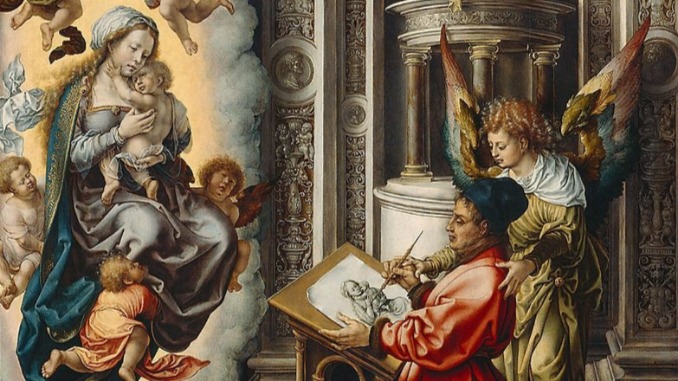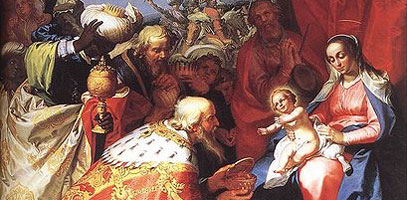
As we move toward the third week of Advent, now is a good time of the year to consider the Gospel of Luke.
As the third book of the New Testament, Luke offers readers a look at the events leading up to Jesus’ birth, and a beautiful infancy narrative, which gave the world many of the elements of the traditional Christmas story.
The journey to Bethlehem, Jesus’ birth in the stable, angels and visiting shepherds all come from the second chapter of Luke.
Catholics who have heard this year’s Gospel readings, all taken from Luke, know the rest of the book uses glorious language to tell the story of Jesus’ ministry, convey His mercy and care for the poor and outcast, and explain how His death and resurrection redeemed humanity.
“There’s a lot in Luke that touches the heart,” said Sister Pamela Smith, a Sister of Sts. Cyril and Methodius, who said she first read Luke’s Gospel in second grade.
“He was also a great storyteller who used a real literary flair. Some of the classic parables, such as the Good Samaritan and the Prodigal Son, appear only in Luke. You get a real moral sense of what love of neighbor means, of mercy and forgiveness,” she said.
Many things set Luke’s Gospel apart from the other three narratives that tell us about Jesus’ life and works.
Who was Luke?
There is not much concrete historical background about the writer known as Luke the Evangelist. What we know of him comes from information gathered by church historians and scholars through the centuries, and from references in other books of the New Testament.
According to the introduction to the New American Bible, early Christian tradition identified Luke as a Syrian from Antioch, although other scholars say his true birthplace is unknown.
He wrote in Greek, and most historians believe the Gospel dates from 80-85 A.D. Others, however, have said Luke may have been written as early as A.D. 60-65.
Catholic tradition says Luke was a physician, and he is often identified as the figure “Luke, the doctor” who is mentioned elsewhere in the New Testament (Col 4:14).
Scholars believe he was highly educated because of the style of Greek he used, and he wrote primarily for a Gentile audience, according to Andrew L. Minto, a professor of sacred scripture and theology at Franciscan University of Steubenville in Ohio.
Church tradition says Luke was also the author of the Acts of the Apostles, and many scholars believe he was a close friend and companion of Paul.
Luke’s intelligence is evident in the way he organizes his Gospel, and his skill as a writer enables him to combine facts and details with the supernatural aspects of Christ’s life.
“His storytelling captures your attention and is just riveting at times … Luke enriches the whole spiritual atmosphere by constantly having angels involved in events, from the Annunciation at the beginning of the Gospel to the Garden of Gethsemane,” Minto said. “He highlights the spiritual, highly charged view of reality.”
A focus on Mary
Much of what we know about Mary, Christ’s mother, comes from Luke.
“People in the past speculated that Luke may have actually known Mary, because we find all of the stories about her in his Gospel,” said Beth Kreitzer, who teaches history and theology at Belmont Abbey College in Belmont, N.C. “None of the other Gospel writers tell these stories related to her.”
Luke includes the Annunciation, Mary’s visitation with her cousin Elizabeth, the birth of Jesus and His presentation in the temple, and the account of Mary and Joseph finding Jesus, at age 12, speaking with teachers in the temple. Luke is also the source of the Magnificat (1:46-55) and Elizabeth’s words which later became part of the Hail Mary (1:42).
Special concern for women
Women play a prominent role throughout Luke’s Gospel, and many episodes focus on the special care and concern Christ showed to females He encountered throughout His life. Luke introduces readers to many who are not included in the other Gospels, including Elizabeth, the prophetess Anna (2:36-38), and a group of women who travel with Jesus during His ministry (8:1-3).
Luke also relates how Jesus raised a widow’s son from the dead, healed a crippled woman, and forgave a sinner who anoints His feet with her tears.
Women were also the first witnesses to Jesus’ resurrection.
Major themes
Throughout his Gospel, Luke focuses on Christ’s message of mercy, love and compassion.
“He is interested in showing that Jesus’ person and mission is universal, that it extends not just to the people of Israel but to all the world,” said Msgr. Stuart Swetland, vice president for Catholic Identity and professor of Christian ethics at Mount St. Mary’s University in Emmitsburg, Md. “During much of the Gospel, we see Jesus marching to Jerusalem, with the determination that He’s going to continue to be faithful to His vocation of revealing to the world the merciful love of His father.”
Luke also stresses the importance of prayer, discipleship, the Holy Spirit, and repentance.
Christ’s concern for the poor, for sinners, and other outcasts is a constant theme. The Gospel offers a model of social justice for all Christians.
“Luke, unlike some of the other books in the New Testament, did not stress an apocalyptic end of the world,” Kreitzer said. “Luke asks us to consider how do we actually live in the world as Christians, and how is it all going to work?”
Luke’s reliance on historical fact and details also helps to reinforce Jesus’ role as the Messiah and only true source of salvation.
In the Gospel’s final chapter, Jesus appears to two disciples on the road to Emmaus, and then to the other disciples in Jerusalem, and reveals to them how He fulfills the prophecies in the Old Testament.
This article was first published in The Miscellany in December 2010.



